What is Euglena?
The term Euglena denotes a genus of unicellular, flagellated eukaryotic organisms (protists).
In many habitats (freshwater, moist soils, brackish waters) these organisms are found.
The cell is bounded by a flexible proteinaceous pellicle (not a rigid cell wall), which allows shape changes (metaboly) under movement pressures.
One or two flagella (one often emergent) are possessed by the cell. The emergent flagellum is used for locomotion in aqueous medium.
An eyespot (stigma) plus a photoreceptive organelle (paraflagellar body) are present near the flagellum base, enabling phototaxis (movement toward or away from light).
Chloroplasts containing chlorophyll a and b are present in many Euglena species; photosynthesis is performed under suitable conditions.
Storage of photosynthate is done in the form of paramylon (a β-1,3-glucan), in discrete paramylon bodies in the cytoplasm.
When light is unavailable, heterotrophic nutrition (phagocytosis, uptake of dissolved substances) is adopted, making Euglena mixotrophic under many circumstances.
Reproduction is by asexual binary fission (longitudinally), with nucleus dividing by mitosis, followed by cytoplasmic division.
Formation of resting cysts is possible under adverse environmental conditions (drought, nutrient scarcity) so that the organism may survive until conditions improve.
In taxonomy, Euglena is placed in phylum Euglenozoa (or Euglenophyta in older schemes), class Euglenoidea / Euglenida, order Euglenales.
Some species (for example Euglena gracilis) are intensively studied as model organisms in cell biology, photosynthesis research, and metabolism studies.
Applications such as biofuel production, nutraceutical supplementation, environmental monitoring are being investigated (because Euglena can produce lipids, vitamins, antioxidants).
In blooms, Euglena may proliferate to such density that water color is visibly changed (green in E. viridis, red in E. sanguinea).
Its flagellar and phototactic behavior can lead to patterns such as bioconvection in suspensions under light gradients.12345
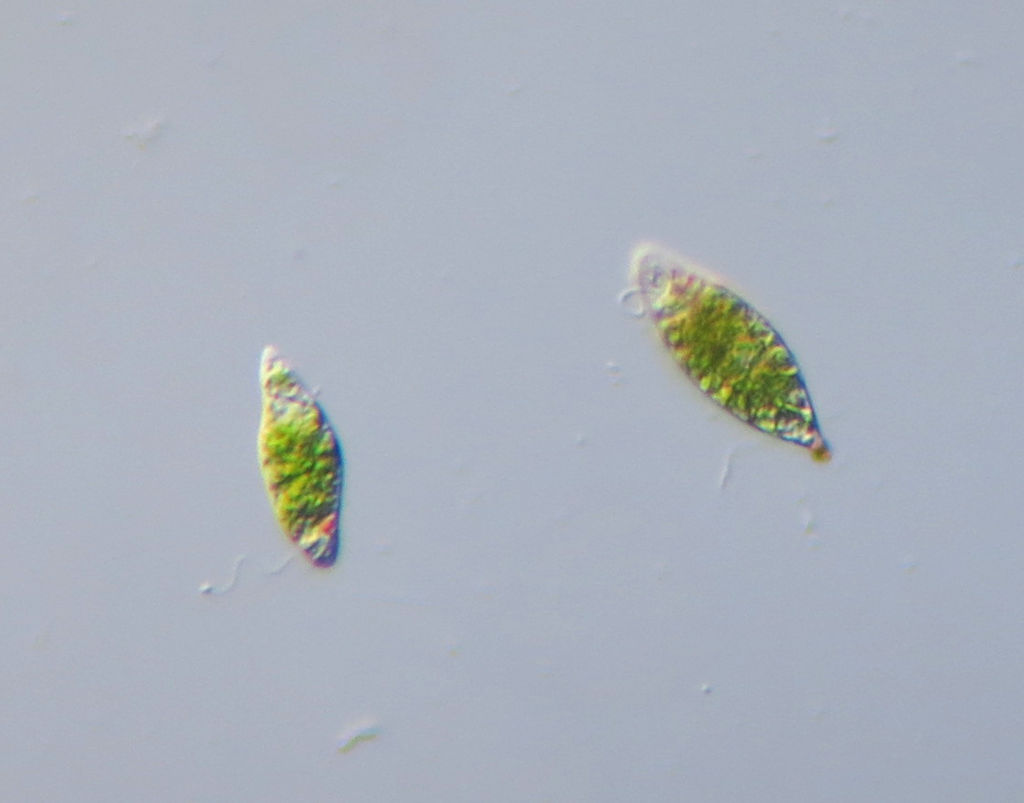
Definition of Euglena
Euglena is a genus of single-celled microorganisms found in water, capable of photosynthesis and movement.
General Characteristics of Euglena
- The cell is unicellular, and a eukaryotic organization is exhibited.
- In fresh water, brackish water, and moist soils, the organism is commonly found.
- A flexible pellicle (protein strips beneath the plasma membrane) is present instead of a rigid cellulose cell wall; thus, cell shape change is allowed (metabolism).
- One or two flagella are borne, with one long flagellum often emergent and used for locomotion.
- The eyespot (stigma) plus paraflagellar body (photoreceptor) are located near the flagellum base, so phototactic responses are enabled.
- Chloroplasts (with chlorophyll a and b) are contained in many species, so photosynthesis is performed under proper light conditions.
- Paramylon (a β-1,3 glucan) is stored as a reserve carbohydrate in paramylon bodies inside cytoplasm.
- When light is insufficient, heterotrophic nutrition is adopted by absorption or phagocytosis of organic matter; thus, mixotrophy is exhibited.
- Reproduction is done by asexual binary fission (longitudinal division) with mitotic nucleus division, then cytokinesis.
- Resting cysts may be formed under adverse conditions (drought, nutrient deficiency) so that survival is ensured until favorable conditions return.
- Diverse chloroplast morphologies (axial, stellate, and parietal) and variable paramylon arrangements are observed across species.
- The number of species is large; Euglena is one of the best-studied genera among euglenoids.
- Tolerance to variable environmental stresses (temperature, light changes, and nutrient fluctuations) is displayed by many species.
- In dense populations, blooms may occur, and water coloration may be altered (green in E. viridis, red in E. sanguinea).
- Bioconvective patterns may be generated in suspensions because of collective phototactic behavior and swimming responses.678
Habitat of Euglena
The species are found largely in freshwater habitats such as ponds, ditches, lakes, slow-moving streams.
In brackish water zones (estuaries, mangrove fringes), some species are tolerated / observed.
Within moist soils or mud (especially damp, organic-rich soil) presence is recorded occasionally.
In eutrophic water bodies (nutrient-rich, with organic load) populations are often high because conditions are favorable.
At water surfaces or zones with good light penetration the organisms are often concentrated, because photosynthesis is enabled.
During adverse environmental conditions (drought, desiccation of water body) resting cysts may be formed, so that survival is assured until favorable habitat returns.
In polluted / organic-polluted waters Euglena may thrive, being tolerant to moderate levels of pollution, and may act as bioindicator of organic pollution.
At times blooms are produced in stagnant waters, surfaces of ponds or ditches, and coloration of water may change (green, red) when densities are high.
The geographical distribution is cosmopolitan (widely across world), wherever suitable aquatic / moist habitats exist.
At extremes of temperature / light / moisture the organisms must endure stress, but many species are robust and tolerable to variable habitat conditions (temperature shifts, light variation, nutrient fluctuations).91011
Food and Nutrition of Euglen
- The nutrition of Euglena is often mixotrophic, meaning both autotrophy and heterotrophy are employed.
- Under light and suitable conditions, photosynthesis is effected by chloroplasts containing chlorophyll a and b.
- Carbohydrates and energy are synthesized from CO₂ and light, and stored as paramylon (a β-1,3-glucan) in paramylon bodies in cytoplasm.
- In absence of light, organic compounds (such as sugars, acetate, ethanol) are absorbed / ingested by Euglena for heterotrophic nutrition.
- Osmotrophy (absorption of dissolved nutrients) is practiced, especially when external organic molecules are available.
- Phagocytosis (ingestion) may be used in some species or under certain conditions to capture particulate organic matter.
- When heterotrophic growth is sustained, paramylon accumulation is often increased (cells store more reserve carbohydrate) because photosynthesis is reduced.
- Under mixotrophic conditions (light + organic carbon), both pathways (photosynthesis + uptake) operate concurrently, and nutritional flexibility is maximized.
- Protein, lipids (especially unsaturated fatty acids), and other biomolecules are synthesized, depending on trophic mode and environmental factors (light, carbon sources).
- The use of organic carbon sources (glucose, acetate, ethanol etc) in culture media has been demonstrated to enhance biomass and paramylon yield.
- Under stress (for example salt stress) paramylon accumulation is sometimes upregulated, as reserve storage, while photosynthetic pigments may decline.
- The metabolic interactions between chloroplast and mitochondria (particularly under low O₂ or mixed nutrition) assist in paramylon synthesis via pathways linking organic carbon metabolism and CO₂ fixation.
- When deprived of both light and organic nutrients, survival is impaired, and growth ceases.12131415
Morphology and Anatomy
- The cell is unicellular and an eukaryotic organization is exhibited.
- In shape an elongated / spindle / ovoid form is adopted, with length ranging from ~ 15 to 500 µm.
- A flexible pellicle (made of proteinaceous strips + underlying microtubules) is present beneath plasma membrane; rigidity is avoided, shape change (metaboly) is enabled.
- The pellicle strips are arranged in spiral fashion, and sliding among them is allowed so that body flexibility is given.
- Plasma membrane (thin, semipermeable) encloses the cytoplasm and organelles.
- The nucleus (single) is located in central region, with chromatin, nucleolus etc, housing genetic material.
- Chloroplasts (in many species) are present, containing chlorophyll a and b, enabling photosynthesis under light.
- Pyrenoids (within chloroplasts) are present, involved in carbon fixation / paramylon synthesis, sometimes with sheaths of starch.
- Paramylon bodies (storage of β-1,3-glucan) are distributed in cytoplasm, as reserve carbohydrate granules.
- Mitochondria, endoplasmic reticulum, Golgi apparatus, ribosomes and other common eukaryotic organelles are present in cytoplasm.
- A contractile vacuole is present for osmoregulation; excess water is expelled via a reservoir or pocket near flagellar insertion.
- A reservoir (or flagellar pocket) is present near the base of the flagellum, from which the flagellum emerges
- Two flagella are rooted in basal bodies within the reservoir; one flagellum is often emergent (long) and used for locomotion, while the other is short / non-emergent.
- Mastigonemes (fine filaments) may be present along the emergent flagellum in some species.
- A stigma (eyespot) with pigmented granules is present near the flagellar base; a photoreceptive paraflagellar body is associated, so phototaxis (light orientation) is mediated.
- The stigma filters light which then reaches photoreceptor structure; rotation of cell helps in directional sensing.
- Some species possess mucocysts beneath pellicle, producing mucilaginous threads; presence/shape of mucocysts may assist in species identification.
- Cytoplasmic streaming and organelle movement are enabled in the internal cytosol, facilitating distribution of nutrients and metabolites.
- No rigid cellulose cell wall is present; rigidity is avoided to permit flexibility.
- In summary, the morphology & anatomy of Euglena combine flexibility, flagellar locomotion, photoreceptive structures, photosynthetic organelles, and general eukaryotic internal components.16171819
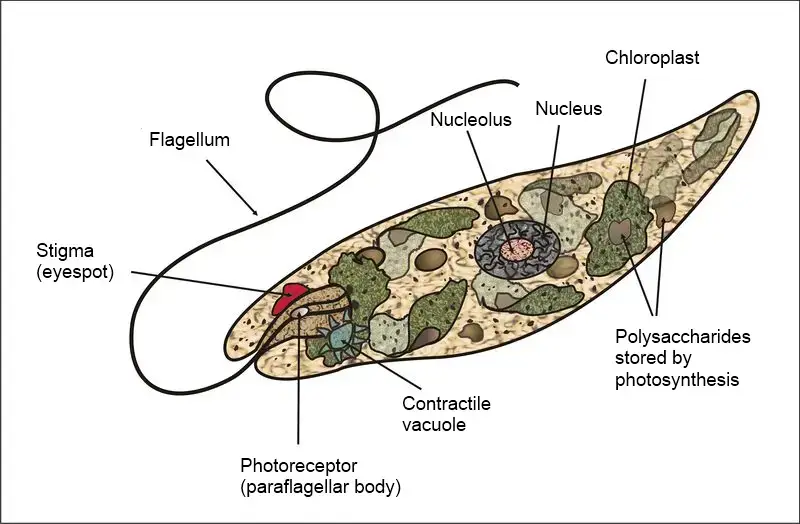
Internal Structure and Components of Euglena – Euglena Cell Anatomy
A typical photosynthetic Euglena cell contain these following structures;
- Pellicle — A flexible, proteinaceous covering is provided beneath the plasma membrane; strip-like protein bands (supported by microtubules) are used so sliding among them is enabled, thus shape changes (metaboly) are allowed.
- Plasma membrane — A thin, semipermeable membrane is enclosed around cytoplasm and internal organelles, thus boundary and regulation of exchange is maintained.
- Cytoplasm — A gel-like aqueous medium is occupied by organelles and solutes; metabolic reactions are carried out in it.
- Chloroplasts — Plastids containing chlorophyll a and b are contained in many species; light energy is absorbed and used in photosynthesis.
- Pyrenoids (within chloroplasts) — Structures for carbon fixation and paramylon synthesis are often enclosed, sometimes with sheaths of starch around them.
- Paramylon bodies — Granules / storage bodies of a β-1,3 glucan are stored in the cytoplasm as reserve carbohydrate, for times when photosynthesis is not feasible.
- Nucleus — A membrane-bound structure is present containing DNA, with nucleolus, chromatin etc; genetic regulation is handled there.
- Nucleolus — Within nucleus, the nucleolus is present for synthesis of rRNA and assembly of ribosomal subunits.
- Mitochondria — Energy generation is done by mitochondria via respiration and metabolic pathways.
- Ribosomes — Sites of protein synthesis are present (composed of RNA + proteins), dispersed in cytosol or on ER.
- Endoplasmic reticulum (ER) — Membranous network is provided, with rough ER (with ribosomes) and smooth ER (without), for protein synthesis, lipid synthesis, transport.
- Golgi apparatus — Organelles for processing, packaging, and trafficking of molecules (proteins, lipids) are found.
- Lysosomes — Enzyme-containing vesicles are anticipated to digest macromolecules, though their degree of differentiation in Euglena may vary.
- Contractile vacuole — A vacuole is present for osmoregulation; excess water is expelled to avoid cell swelling / bursting.
- Reservoir (flagellar pocket / inward pocket) — An inward pocket is located near the anterior of the cell; flagella originate from basal bodies within it, and the contractile vacuole expels water via this opening.
- Flagella — Two flagella are rooted in basal bodies within the reservoir; typically one is long and emergent (used for locomotion), while the other is short and non-emergent.
- Mastigonemes — Fine filamentous structures may coat the emergent flagellum in some species.
- Eyespot (stigma) — A pigmented granule region (often red) is positioned near the base of the flagellum; light filtering is done so photoreceptor is aided.
- Photoreceptor / Paraflagellar body — A light-sensitive organelle is located adjacent to the flagellum base (often near eyespot); detection of light direction is done, enabling phototaxis.
- Mucocysts — In some species, beneath pellicle mucilaginous secretory bodies (mucocysts) are present; threads may be secreted; these are useful in species diagnosis.202122
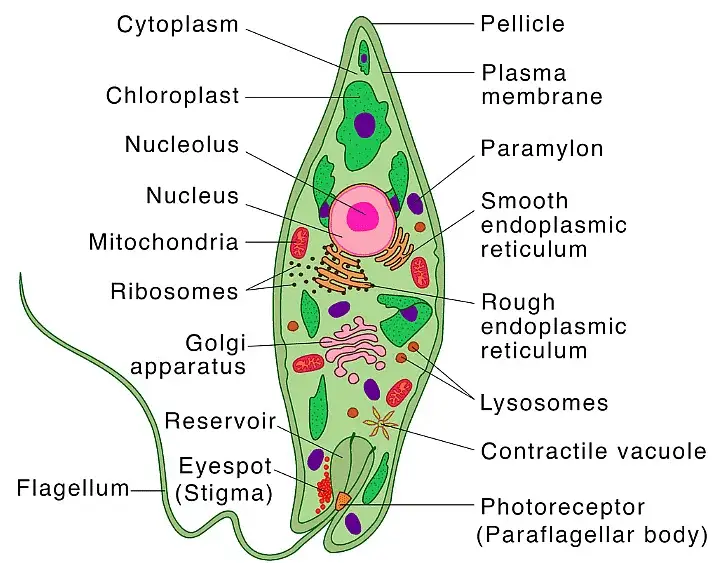
Classification of Euglena
The domain Eukaryota is assigned to Euglena, thus eukaryotic features are possessed.
Within Eukaryota, Euglena is placed in the supergroup (or clade) Excavata / Discoba, under phylum Euglenozoa.
The class Euglenophyceae (or sometimes Euglenoidea / Euglenida) is used for Euglena in many classifications.
Order Euglenales is the order to which Euglena belongs.
The family Euglenaceae (or under some codes Euglenidae) includes Euglena and related genera.
Genus Euglena is the genus level; many species (for example Euglena gracilis, Euglena viridis) are included under it.
Below genus, various species are recognized; for example Euglena gracilis, Euglena viridis, Euglena sanguinea, among others.
In modern taxonomy, some species that were once placed in Euglena have been reassigned to other genera (such as Lepocinclis, Phacus, Discoplastis, Euglenaria, Euglenaformis) based on molecular phylogeny
Within Euglenophyceae, three orders are often recognized: Euglenales, Eutreptiales, and Rapazida (the latter sometimes representing mixotrophic or special lineages).
Many genera (besides Euglena) are included in Euglenophyceae: Ascoglena, Eutreptia, Eutreptiella, Monomorphina, Cryptoglena, Colacium, Trachelomonas, etc.
Because of evolving molecular evidence, classification is somewhat fluid; phylogenetic clades rather than strictly morphological traits are used now.26272829
| Domain | Eukaryota |
| Kingdom | Protista |
| Superphylum | Discoba |
| Phylum | Euglenozoa |
| Class | Euglenoidea |
| Order | Euglenales |
| Family | Euglenaceae |
| Genus | Euglena |
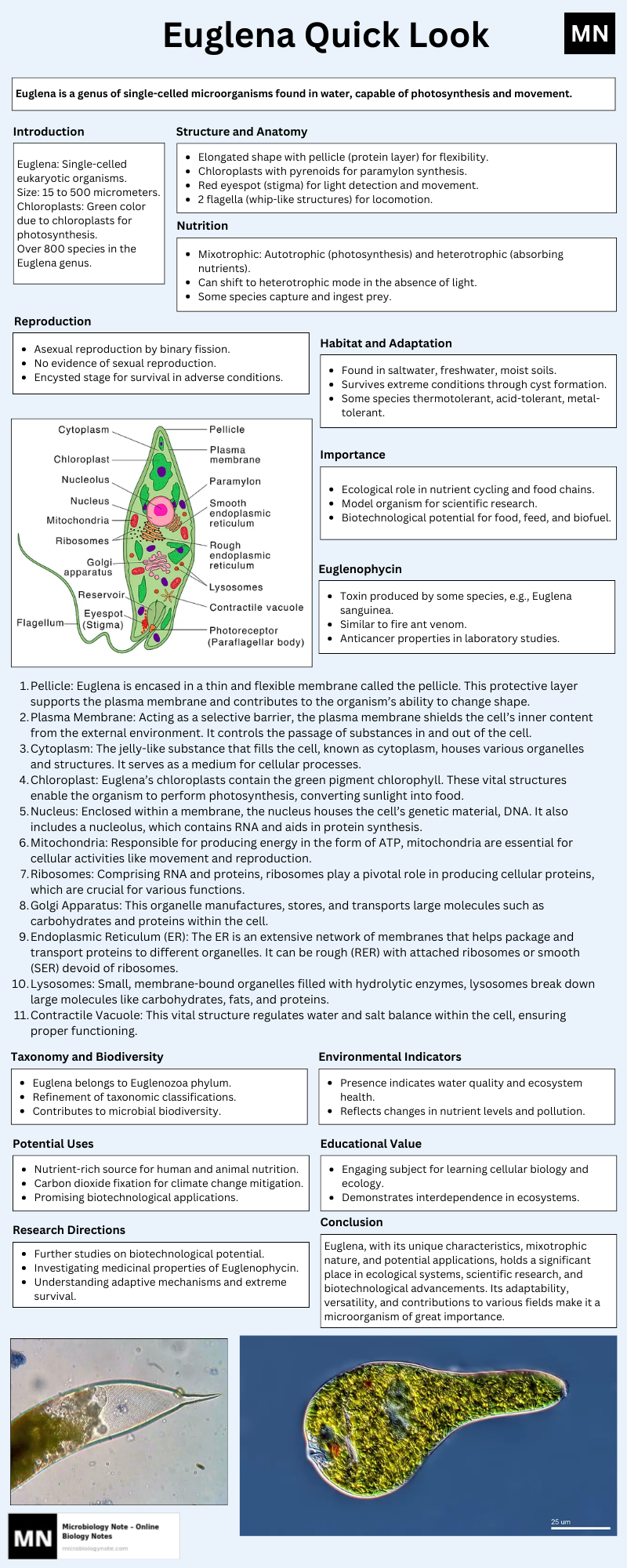
Euglena’s Dual Nature
- The phrase “dual nature” is used to indicate that Euglena exhibits two modes of nutrition rather than one fixed mode.
- In light / with adequate light, autotrophic nutrition is performed by Euglena via chloroplasts, so photosynthesis is used to produce organic compounds from CO₂ and light.
- In darkness / when light is absent, heterotrophic nutrition is adopted by Euglena by absorbing / ingesting organic substances from environment (osmotrophy, phagocytosis)
- Because both autotrophy and heterotrophy are possible, Euglena is described as mixotrophic; this term embodies its dual nature.
- Under mixotrophic conditions, both pathways (photosynthesis + uptake/use of external organics) are operated simultaneously, depending on availability, so flexible metabolism is enabled.
- The ability to switch between or combine nutritional modes gives Euglena an advantage under variable environmental conditions, e.g., in low light, nutrient-rich waters heterotrophy helps survival.
- In absence of light, reliance on stored reserves (paramylon) plus uptake of organic nutrients is done to sustain metabolism; photosynthetic machinery may be downregulated.
- Under conditions favorable to photosynthesis, heterotrophic uptake may be reduced, though residual uptake mechanisms remain available.
- The “dual nature” thus reflects a metabolic plasticity — capacity to adapt trophic mode to prevailing conditions.
- Because of this dual nature, Euglena occupies an intermediate biological niche, showing traits typical of “plants” (photosynthesis) and of “animals” (ingestion or absorption) — though it is placed in Protista not Plantae/Animalia.
- The dual nature has been exploited in cultivation / biotechnological uses, where mixed nutrition (light + organics) is used to maximize growth, metabolite yield etc.
- The concept of “dual nature” is sometimes loosely phrased as “both plant and animal features present” — but strictly it means nutritional duality and flexibility.
- Because Euglena’s chloroplasts are of secondary endosymbiotic origin (3 membranes) the photosynthetic capacity is derived via evolutionary acquisition which supports its dual nature.252423
Plant-like Characters
- Chloroplasts are possessed, and photosynthesis is carried out when light is available.
- Paramylon (a starch-like carbohydrate) is stored internally as reserve food.
- Pyrenoids are present within chloroplasts, facilitating carbon fixation and storage.
- A red eyespot (stigma) is present, which filters light so that photoreceptor is stimulated for photosynthetic orientation.
- In bright light, autotrophic mode is preferred; CO₂ and light are converted into organic compounds.
Animal-like Characters
- Flagellum is used for motility, allowing the organism to swim toward or away from stimuli.
- Heterotrophic nutrition is adopted in absence of light by absorbing or ingesting organic substances
- Contractile vacuole is used for osmoregulation, expelling excess water to maintain internal balance.
- Movement by metaboly or body shape change is possible, which is characteristic of motile “animal” behavior.
- A flexible pellicle (not a rigid cell wall) allows shape adjustments and movement in fluid environment.
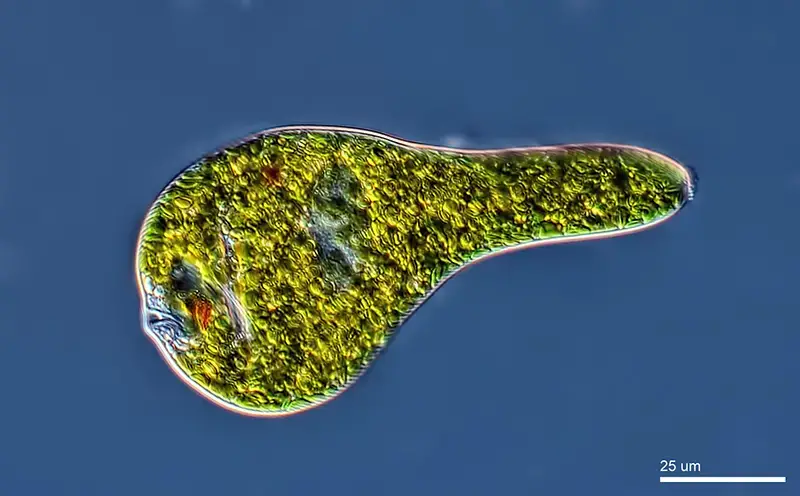
Locomotion and Phototaxis movement
- The locomotion is performed via a flagellum, which is emergent and used to propel the cell in water.
- In addition to flagellar swimming, euglenoid movement (metaboly) is exhibited: sliding of pellicle strips and shape changes cause slow gliding or wriggling motion especially on surfaces.
- Under confinement, peristaltic body deformations (crawling-like motion) may be adopted when flagellar swimming becomes ineffective
- The locomotory modes include forward translation, spin (rotation about longitudinal axis), and turns (left / right), which allow maneuvering.
- Movement is controlled by changes in flagellar beating patterns, directed by internal signal transduction pathways.
- Phototaxis (movement in response to light) is exhibited: the organism moves toward or away from light depending on intensity (positive phototaxis toward light, negative phototaxis away from strong light).
- The eyespot (stigma) filters light before it reaches the photoreceptor (paraflagellar body), so directional light sensing is enabled as the cell rotates.
- Photophobic (shock) responses are elicited when a sudden change in light intensity occurs (either increase or decrease), causing abrupt changes in swimming direction.
- The phototaxis behaviour is modulated by light intensity: in dim light positive phototaxis is favored; in high light negative phototaxis or avoidance is triggered (photoresponse inversion).
- Localized bioconvection patterns can result from collective phototactic movement in dense suspensions, causing convection cells based on upward/ downward swimming and lateral phototaxis.36
Locomotion Process / Steps of Euglena
- The flagellum is extended from basal bodies situated in the reservoir / flagellar pocket; it emerges outward and is ready for beating.
- Undulatory waves are initiated at the base of the flagellum and travel toward its tip; these waves are spiral / helical in nature.
- As the flagellar waves push against the surrounding medium, forces are generated — one component along the body axis (forward thrust) and another component perpendicular causing rotation.
- The cell body rotates about its longitudinal axis (approx one full turn per second in many cases) while being propelled forward; the path thus is spiral / helical around a straight axis.
- During motion, the flagellum remains directed obliquely backward relative to the cell axis; this orientation helps in producing the combined forward + rotational movement.
- Under conditions where flagellar motion is inefficient (e.g., near surfaces, in viscous medium, or when constrained), euglenoid movement (metaboly) is adopted: a peristaltic wave of contraction and expansion passes from the anterior to posterior end.
- The body becomes successively shorter (wider) starting from anterior, then mid, then posterior regions.
- Pellicle strips slide over one another (ridge/groove sliding) and cytoplasmic contractile elements (myonemes or localized fibrils) assist bending / movement.
- Muciferous secretions may lubricate sliding of pellicle layers during the shape changes.
- A behavioural switch occurs: flagellar swimming is prioritized in free medium, whereas metaboly is used in constrained conditions.
- Throughout both modes, energy is provided by ATP produced by mitochondria; the coordination of flagellar beating, pellicle sliding and cytoskeletal control ensures displacement.3031
Structure of Flagellum in Euglena
- The flagellum is enveloped by a flagellar membrane / outer coat, which is continuous with cell’s plasma membrane; this outer sheath is somewhat contractile
- Beneath the membrane, the core axoneme is present; microtubules and associated proteins are organized in the “9 + 2” pattern (nine outer doublets surrounding central pair) as in typical eukaryotic flagella.
- The paraflagellar rod (PFR) is an extra-axonemal structure that runs alongside certain doublets (1, 2, 3) and is connected by links; it influences bending mechanics and beat geometry.
- The microtubule doublets in the axoneme are modified: each outer doublet has an A tubule (complete) and B tubule (partial) in typical fashion.
- Transition occurs between axoneme and basal anchoring; the basal bodies (blepharoplasts) act as microtubule organizing centers and basal granules are located just beneath reservoir base.
- In most species only one flagellum emerges (the dorsal or emergent flagellum) and the second (ventral) remains inside reservoir or is reduced / non-emergent.
- Mastigonemes (fine hair-like filaments) are borne on the surface of the emergent flagellum (≈10,000 per cell) and contribute to motility interactions with medium.
- The PFR / axoneme interaction helps establish the spontaneous bending plane and non-planar beating patterns (such as “spinning lasso” motion in Euglena gracilis).
- The long emergent flagellum is used as propulsive organelle; its beating produces rotation (gyration) and forward thrust by pushing fluid backward.
- Structural continuity is maintained: microtubules extend throughout the length of axoneme, and the outer membrane sheath surrounds them.373839
Ultrastructure of Flagellar in Euglena
- The long flagellum is composed of two major ultrastructural parts — outer coat and axoneme.
- The outer coat is a contractile membranous sheath continuous with the cell’s plasma membrane.
- The axoneme is the inner core, consisting of microtubules and associated proteins arranged in a canonical “9 + 2” pattern.
- In the axoneme, nine peripheral doublets surround two central singlet microtubules (central pair).
- In each outer doublet, an A tubule is complete, and a B tubule is partial.
- Dynein arms (inner and outer) are attached to the A tubules and extend toward adjacent doublets; these arms generate sliding forces.
- Nexin links connect neighboring doublets circumferentially (at ~ 96 nm intervals).
- Radial spokes project from the A tubule toward the central pair at periodic intervals (~88-96 nm).
- A paraflagellar rod (PFR) is present adjacent to the axoneme (parallel to certain doublets), and is connected by linking structures.
- The PFR influences flagellar beat geometry, and helps select the spontaneous bending plane.
- The PFR is mechanically coupled with the axoneme; asymmetries in this coupling contribute to non-planar beating (e.g. “spinning-lasso” motion).
- Mastigonemes (fine filamentous structures) coat the exterior surface of the flagellum.
- Two types of mastigonemes (long ~3 µm, short ~1.5 µm) are found, non-tubular in nature, and many (≈ 30,000) are attached to paraflagellar rod or microtubules.
- These structures may be involved in fluid interaction / hydrodynamics of flagellar motion.
- The basal body (blepharoplast) structure is similar to an axoneme but differs: the basal body has nine triplet microtubules (instead of doublets) and lacks central pair.
- Two basal bodies are present, from which the two flagella (emergent and non-emergent) originate.
- The transition zone between basal body and axoneme involves a change from triplets to doublets.
- The microtubular root system is associated with the reservoir and flagellar roots: multiple microtubular roots subtend the reservoir from basal bodies.
- A fourth band of microtubules is sometimes nucleated from a root and lines a cytoplasmic pocket contiguous with the reservoir.
- The continuity of microtubules is maintained along axoneme length: microtubular structures extend through the entire flagellar shaft.
- The structural proteins in the flagellum are complex: proteomic studies in Euglena gracilis indicate a large complement of proteins (≈ 1700 protein groups) localized to flagella (including glycolytic, signalling, structural proteins).404142
Reproduction of Euglena
- The reproduction is carried out asexually; no well-substantiated sexual reproduction is known.
- First the nucleus is divided by mitosis; chromosomal duplication and separation are done such that each daughter cell obtains full complement of genetic material.
- Next organelles (chloroplasts, flagellar basal bodies, stigma, pellicle components, etc) are duplicated so that each prospective daughter cell receives necessary cell parts.
- A cleavage furrow is formed beginning from the anterior (front) end of cell; a V-shaped bifurcation is progressed posteriorly until full separation is achieved.
- Longitudinal binary fission (division along the long axis) is used; the cell is split into two daughter individuals.
- During division the stigma (eyespot) is lost / disappears temporarily, and new ones are regenerated / formed in each daughter cell after separation.
- The flagellum(s) are shortened / retracted during division; after separation new flagella are regenerated in daughter cells.
- Under unfavorable environmental conditions, encystment (formation of a thick-walled cyst) is adopted so that survival is enabled until the conditions improve.
- A special “palmelloid” stage is sometimes reported: cells may lose flagella, aggregate within gelatinous mass, divide internally, and later release flagellated daughter cells.
- The life cycle includes a motile (free-swimming) stage and sometimes a non-motile (cyst / encysted) stage.3233
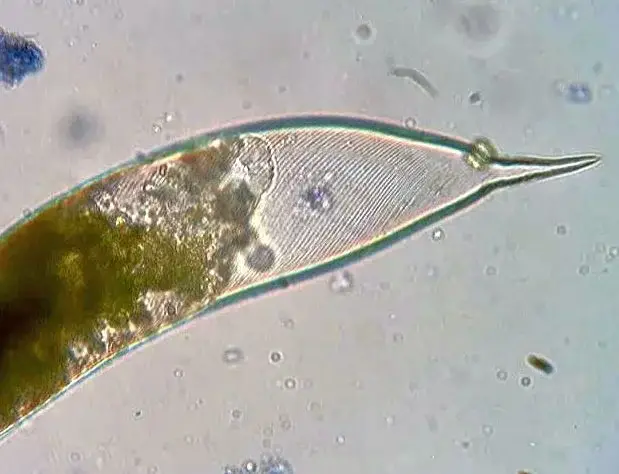
Summary of Life Cycle & Reproduction (stepwise / stages)
- In favorable aquatic conditions the organism remains in a free-swimming, flagellated form; motility is maintained and normal metabolism is sustained.
- Under environmental stress (nutrient shortage, extreme light, drought etc), a palmelloid stage may be adopted: cells lose their flagella, become non-motile, and may be embedded in gelatinous mucilage.
- In palmelloid condition reproductive cysts are formed within the gelatinous mass; internal divisions may take place, producing multiple daughter cells.
- When conditions ameliorate (favorable moisture, nutrients, light), the daughter cells become flagellated and escape from the cyst / mucilage mass to resume free motile life.
- In motile stage reproduction is effected by longitudinal binary fission (cell splits along its long axis) after mitotic duplication of nucleus & organelles.
- Flagellar apparatus, stigma, gullet etc are duplicated before cleavage
- Cleavage begins at the anterior, forming a V-shaped furrow which gradually moves posteriorly until complete separation is achieved.
- During unfavorable periods thick-walled protective cysts may be formed (encystment) so that survival in dormant stage is enabled until conditions improve.
- The life cycle alternates between motile phase and nonmotile / cyst / palmelloid phases, depending on environment.
Why Euglena is known as Mixotrophs?
- The term “mixotroph” is applied because Euglena is able to combine autotrophic and heterotrophic modes of nutrition.
- Under illumination, photosynthesis is carried out by chloroplasts in Euglena, enabling it to fix CO₂ into organic compounds (autotrophy).
- In absence of light (or when light is limiting), organic nutrients are absorbed or ingested from environment (heterotrophy) to sustain metabolism.
- Because both nutritional strategies (photosynthesis + uptake / ingestion) are utilized depending on environmental condition, the dual capability is exhibited (i.e. mixotrophy).
- When organic carbon sources (e.g. glucose, acetate) are available along with light, both pathways may operate simultaneously, increasing growth / biomass yield.
- The flexibility in switching nutritional modes gives Euglena an adaptive advantage under fluctuating environmental conditions (light, organic matter availability).
- In Euglena gracilis, mixotrophic behavior is well documented: both phototrophy and heterotrophy are used.
- Because mixotrophy is essentially the use of mixed sources of energy / carbon (not solely a single trophic mode), Euglena fits the formal definition of mixotrophs.
- In cultivation / biotechnological settings, mixotrophic cultivation is exploited to enhance biomass and product yield (paramylon, lipids etc) by providing both light & organic substrate.
- The “mixo-” prefix underscores that more than one trophic strategy is employed, as opposed to strict autotrophy or strict heterotrophy.
Importance of Euglena
- The role as primary producer is fulfilled by Euglena in aquatic ecosystems, and base of food chains is supported.
- Because mixotrophy is possible, nutrient cycling (carbon, nitrogen) is enhanced in environments where it lives.
- In water bodies Euglena helps in oxygen production (by photosynthesis) and CO₂ uptake, contributing to gas balance.
- The organism is used as a model organism in cell biology, photosynthesis, photoreception, motility and metabolic studies.
- Valuable bioproducts (proteins, lipids, vitamins, paramylon) are produced by Euglena in industrial / biotechnological contexts.
- The polysaccharide paramylon (β-1,3 glucan) is synthesized by Euglena and has applications in nutraceuticals, immunostimulants etc.
- In bioremediation the organism is applied: heavy metals, organic pollutants, wastewater may be treated using its tolerance and uptake capacities.
- As a source of biofuel / bioenergy, Euglena is explored because lipid / wax ester content is high under certain cultivation; sustainable fuel production is being investigated
- The potential in food security is recognized: Euglena biomass is nutritive, containing vitamins, proteins, trace elements; it may be used in health food / dietary supplements.
- In space / closed systems, Euglena is considered for life support (oxygen production, CO₂ removal, food supply) in long-term missions.
- In medical / pharmaceutical research, compounds from Euglena (antioxidants, bioactives, antimicrobial, immunomodulators) are explored for therapeutic applications.
- In monitoring / indicator role, Euglena species (like E. gracilis) are used to detect pollutants (e.g. phenol) in aquatic systems.
- Genetic diversity / metabolic complexity in Euglena has contributed to evolutionary biology, particularly studies on endosymbiosis, chloroplast origin, horizontal gene transfer.3435
Euglena Under Microscope Video
Red Euglena sp.
Euglena mutabilis, showing metaboly, paramylon bodies and chloroplasts
Euglena sanguinea
Euglena, moving by metaboly and swimming
FAQ
What is Euglena?
Euglena is a genus of single-celled organisms known as protists. They belong to the phylum Euglenozoa and are characterized by their unique ability to perform photosynthesis like plants and consume organic matter like animals.
How do Euglena cells obtain energy?
Euglena cells have chloroplasts containing chlorophyll, allowing them to produce energy through photosynthesis using sunlight. In the absence of light, some Euglena species can switch to heterotrophic mode and absorb nutrients from their environment.
What is the role of the red eyespot in Euglena?
The red eyespot, also known as stigma, is a photoreceptor organelle located at the base of the flagellum. It helps Euglena detect light intensity and direction, aiding in the process of phototaxis or movement towards or away from light.
How does Euglena move?
Euglena moves using whip-like structures called flagella. The longer flagellum is primarily responsible for locomotion, while the shorter one assists in steering and changing direction.
Can Euglena be harmful?
While many Euglena species are harmless, there is a species called Euglena sanguinea that produces a toxin known as euglenophycin. This toxin has been found to have toxic effects on fish and even potential anticancer properties in certain contexts.
What is the reproductive process of Euglena?
Euglena reproduces asexually through a process called binary fission. The cell divides into two daughter cells, each containing a nucleus, flagella, and other organelles.
Where can Euglena be found in nature?
Euglena can be found in a variety of environments, including freshwater ponds, lakes, and moist soils. Some species are even capable of surviving extreme conditions such as high temperatures and acidic environments.
Can Euglena be used for commercial purposes?
Yes, certain species of Euglena, particularly Euglena gracilis, have potential commercial applications. They can be cultivated for their nutritional value, including proteins, lipids, and paramylon (a carbohydrate). Euglena cultivation has been explored as a potential source of alternative food and biofuel.
How do Euglena respond to adverse environmental conditions?
Euglena has a survival strategy in which it surrounds itself with a protective wall, forming a dormant stage called a cyst. This enables the organism to withstand unfavorable conditions until the environment becomes more conducive to growth.
Is Euglena more similar to plants or animals?
Euglena exhibits characteristics of both plants and animals. It can perform photosynthesis like plants, using chloroplasts to produce energy, but it can also consume organic matter like animals. This unique mix of traits classifies Euglena as a mixotroph, capable of multiple modes of nutrition.
- Text Highlighting: Select any text in the post content to highlight it
- Text Annotation: Select text and add comments with annotations
- Comment Management: Edit or delete your own comments
- Highlight Management: Remove your own highlights
How to use: Simply select any text in the post content above, and you'll see annotation options. Login here or create an account to get started.